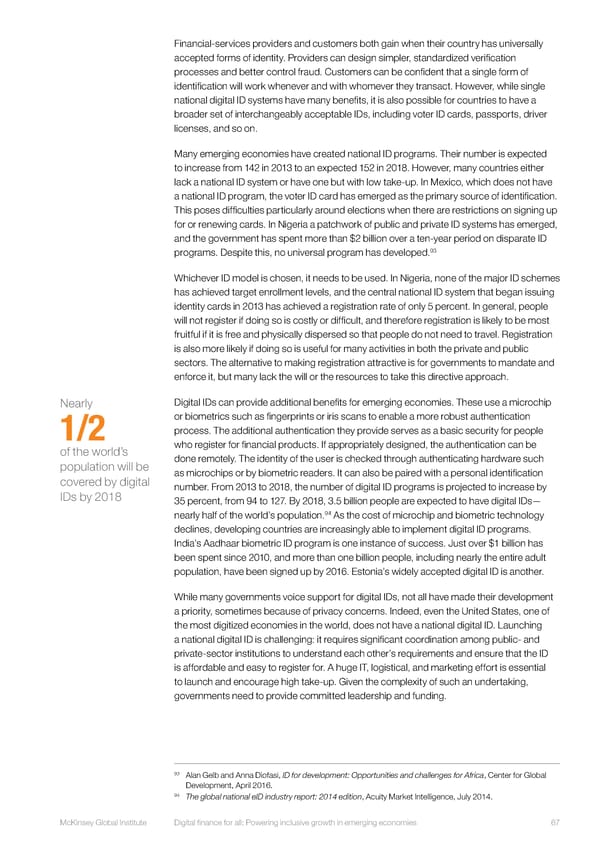Financial-services providers and customers both gain when their country has universally accepted forms of identity. Providers can design simpler, standardized verification processes and better control fraud. Customers can be confident that a single form of identification will work whenever and with whomever they transact. However, while single national digital ID systems have many benefits, it is also possible for countries to have a broader set of interchangeably acceptable IDs, including voter ID cards, passports, driver licenses, and so on. Many emerging economies have created national ID programs. Their number is expected to increase from 142 in 2013 to an expected 152 in 2018. However, many countries either lack a national ID system or have one but with low take-up. In Mexico, which does not have a national ID program, the voter ID card has emerged as the primary source of identification. This poses difficulties particularly around elections when there are restrictions on signing up for or renewing cards. In Nigeria a patchwork of public and private ID systems has emerged, and the government has spent more than $2 billion over a ten-year period on disparate ID 93 programs. Despite this, no universal program has developed. Whichever ID model is chosen, it needs to be used. In Nigeria, none of the major ID schemes has achieved target enrollment levels, and the central national ID system that began issuing identity cards in 2013 has achieved a registration rate of only 5 percent. In general, people will not register if doing so is costly or difficult, and therefore registration is likely to be most fruitful if it is free and physically dispersed so that people do not need to travel. Registration is also more likely if doing so is useful for many activities in both the private and public sectors. The alternative to making registration attractive is for governments to mandate and enforce it, but many lack the will or the resources to take this directive approach. Nearly Digital IDs can provide additional benefits for emerging economies. These use a microchip or biometrics such as fingerprints or iris scans to enable a more robust authentication 1/2 process. The additional authentication they provide serves as a basic security for people of the world’s who register for financial products. If appropriately designed, the authentication can be population will be done remotely. The identity of the user is checked through authenticating hardware such covered by digital as microchips or by biometric readers. It can also be paired with a personal identification IDs by 2018 number. From 2013 to 2018, the number of digital ID programs is projected to increase by 35 percent, from 94 to 127. By 2018, 3.5 billion people are expected to have digital IDs— 94 nearly half of the world’s population. As the cost of microchip and biometric technology declines, developing countries are increasingly able to implement digital ID programs. India’s Aadhaar biometric ID program is one instance of success. Just over $1 billion has been spent since 2010, and more than one billion people, including nearly the entire adult population, have been signed up by 2016. Estonia’s widely accepted digital ID is another. While many governments voice support for digital IDs, not all have made their development a priority, sometimes because of privacy concerns. Indeed, even the United States, one of the most digitized economies in the world, does not have a national digital ID. Launching a national digital ID is challenging: it requires significant coordination among public- and private-sector institutions to understand each other’s requirements and ensure that the ID is affordable and easy to register for. A huge IT, logistical, and marketing effort is essential to launch and encourage high take-up. Given the complexity of such an undertaking, governments need to provide committed leadership and funding. 93 Alan Gelb and Anna Diofasi, ID for development: Opportunities and challenges for Africa, Center for Global Development, April 2016. 94 The global national eID industry report: 2014 edition, Acuity Market Intelligence, July 2014. McKinsey Global Institute Digital finance for all: Powering inclusive growth in emerging economies 67
 DIGITAL FINANCE FOR ALL Page 81 Page 83
DIGITAL FINANCE FOR ALL Page 81 Page 83